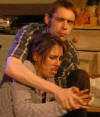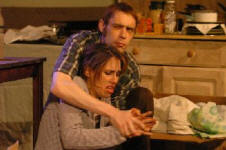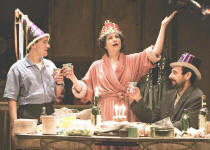|
home
plays
biography
best scene
shop
forum
hot news
photos
much more
- films
- in-depth
- books
-
articles
- glossary
- links
- more links
- search
- site map
- contact
- cold news
all the sites |
Scroll down and click on images for links on the plays.
For links to interviews,
related links, South African history etc click here. |
|
 |
Klaas and the
Devil Jack Barbera
Twentieth Century Literature, Winter 1993
From
my correspondence with Sheila Fugard about her
memoir, a correction to the historical record
about the date of The Cell emerged. Although she
chose not to write about her husband's other
early unpublished play, Klaas and the Devil, both
she and Athol are positive that The Cell was
performed before Klaas. A play review (Anon.
"Three") establishes the first
production of Klaas as 3 October 1956: therefore
the standard date of The Cell's first production,
put at 26 May 1957 by Russell Vandenbroucke (13)
and more generally as 1957 by Stephen Gray (File
11), must be incorrect.
|
 |
The Cell Jack Barbera
Twentieth Century Literature, Winter 1993
She
brings a novelist's eye for detail to her
evocation of people and places during those
financially desperate but exciting apprenticeship
years: baking papier-mache masks in their kitchen
oven for The Cell.
|
 |
The Cell Sheila Fugard
Twentieth Century Literature, Winter 1993
The
origins of The Cell, like so many of Athol's
later plays, were rooted in both the human and
political injustices of South African society. At
the time we met, Athol was emotionally involved
in the problems of our country. Two years
earlier, when he was a seaman on a tramp steamer,
he had worked alongside Malay and black seamen,
and so had learned to live with men of different
skin color. One day he noticed an item in the
local newspaper which both moved and outraged
him. A black woman had been arrested for not
carrying a passbook, the identity document which
blacks were forced to have with them at all
times. She was jailed and, when in prison, gave
birth prematurely. She screamed over and over for
assistance, but her cries were ignored. The
brutal warders left her in the cell to wail over
her dead infant. Finally, the next The origins of
The Cell, like so many of Athol's later plays,
were rooted in both the human and political
injustices of South African society. At the time
we met, Athol was emotionally involved in the
problems of our country. Two years earlier, when
he was a seaman on a tramp steamer, he had worked
alongside Malay and black seamen, and so had
learned to live with men of different skin color.
One day he noticed an item in the local newspaper
which both moved and outraged him. A black woman
had been arrested for not carrying a passbook,
the identity document which blacks were forced to
have with them at all times. She was jailed and,
when in prison, gave birth prematurely. She
screamed over and over for assistance, but her
cries were ignored. The brutal warders left her
in the cell to wail over her dead infant.
Finally, the next day, they removed the bleeding,
stinking thing. Athol created The Cell around
this incident.
|
 |
No-Good
Friday (link has gone) Interview
The great American playwrights, like Arthur
Miller, Tennessee Williams, and Eugene O'Neill
were my first masters. I consciously - as any
apprentice should - tried to copy their craft,
until I felt sufficiently experienced to go in my
own direction.
|
 |
No-Good
Friday Sheila Fugard
Twentieth Century Literature, Winter 1993
Zakes
Mokae, who had just turned twenty, and hardly
ever spoke, was Athol's choice for the role of
"first thug." Athol sensed the acting
potential of this young man, who had been a
protege of Father Trevor Huddleston, an English
cleric who was a political activist in
Sophiatown. Zakes had been a member of Father
Huddleston's jazz group. He was withdrawn, yet
behind his shy grin he was able to project an
undertone of menace. No-Good Friday was the
beginning of Zakes's career, which was to
continue in Athol's later plays in the United
States, as well as in movies.
|
 |
Nongogo
Sheila Fugard
Twentieth Century Literature, Winter 1993
By
the time Athol was writing his next play,
Nongogo, he needed other influences. He had found
a new inspiration in Tone Brulin, a Belgian
theatre director, brought out to South Africa by
the National Theatre. Tone was both a director
and playwright. Athol sat in on his rehearsals
and got a feel for European theatre. This
experience broadened his outlook and gave him
more confidence in himself. Tone sensed Athol's
unique talent. There were township visits with
him, and later we went to Brussels, where Tone
was helpful in getting Athol work in Dutch
theatre.
|
| |
The Blood
Knot
updated as
Blood Knot by 1987 (for links see 1987 version).
|
 |
Hello and
Goodbye Sam
Thielman Curtain Up
This is a play
about decay, after all, and the ugly mid-century
décor is perfectly realized by Sean Doyle's set
and Nina Mahi Zardonzny's costume design. The
production flags somewhat during the longer
monologues, especially those delivered by
Carroll, whose awkward demeanor works better as a
foil for Novack's brashness. Still, Fugard's
morbid spectacle of a dying family unit is a rare
and challenging one, and the undertaking is
ultimately worth the effort.

C. Carroll and K. Novack, Photo: John
Mulcahy
|
 |
The Coat
Dennis Walder
Twentieth Century Literature, Winter 1993
It
was a year before the result became visible, in
The Coat, "An Acting Exercise" which
was presented to its first audience, a white Port
Elizabeth "theatre appreciation" group
who, having asked to see a sample of their work,
were expecting a comedy, Wole Soyinka's Brother
Jero. But since the Native Commissioner would
permit performance in a "white area"
only on condition the black performers did not
use the toilets, and returned to the township
after the show, the Players (after bitter debate)
decided to do a reading of The Coat instead,
using pseudonyms from their earlier roles to
avoid trouble with the police, and a Brechtian
actor-presenter who encouraged their white
audience to think about, not merely sympathize
with, what they were witnessing. Fugard's aim was
to "shatter white complacency and its
conspiracy of silence"; for the group, going
ahead was an act of "solidarity," a
testimony to their work together over the years.
The collaborative procedure, with Fugard as
"scribe" and provocateur, and the
performers drawing on their knowledge of New
Brighton, was fully vindicated by the result,
which left their audience of one hundred and
fifty frozen in "horror and
fascination" (Notebooks 142-43) at being
taken out of their safe white world into township
oppression. As "Lavrenti" (Mulligan
Mbikwane) announces in the opening address: 'We
want to use the theatre. For what?... Some of us
say to understand the world we live in, but we
also boast a few idealists who think that Theatre
might have something to do with changing it
(Township Plays 123).
|
 |
People are
living there
(link has gone) performance
review
As Fugard's intellectual mouthpiece, it is the
character Don who has to conceptualise the
issues, making him a problematic and difficult
character to play.
|
 |
People are
living there
(link has gone) Fugue to
Fugard by Andrew Wilson
While some of Athol Fugard's later works are
marked by claustrophobic symbolism and metaphor,
his earlier plays like Hello and Goodbye and
People Are Living There are finely textured
examples of dirty realism.
|
 |
People are
living there
Richard Hinojosa
14 Jun 2005 nytheatre.com review
People
Are Living There revolves around Milly, the
landlady of a rundown bordering house, who has
recently been cast aside by her long-term lover
and is obsessed with revenge. She finds out that
her ex-lover is going out on a date and decides
to throw a birthday party for herself just to
spite him. But this just doesn’t work out
because her party guests/lodgers Don and Shorty
are victims of their own ineptitude...
The one thing that binds these characters
together is their fear of being alone....
There is a bleak, melancholy shadow over
everything and Fugard gives us few things to
laugh at. (Though not necessarily from lack of
trying) I have to admit that I began to lose
interest in the first half of the play because it
is light on plot and heavy on banter. However,
things really pick up and become interesting
theatre when the party begins. There is about ten
minutes of fantastic theatre when all talking
ceases and we only hear (and see) the characters
attacking the party food. This scene had the most
impact on me. Fugard shows us throughout the play
what happens to us when we sit around and wait
for life to come to us instead of attacking it.
So I saw this scene as a futile attempt at
attacking life and the one moment when the
characters break out of their shells. This is
very refreshing, but then immediately afterward
Fugard falls back on dramatic speeches to reveal
his characters' innermost feelings.

photo © Richard Termine
|
| |
The Last Bus a workshop
piece.
|
|